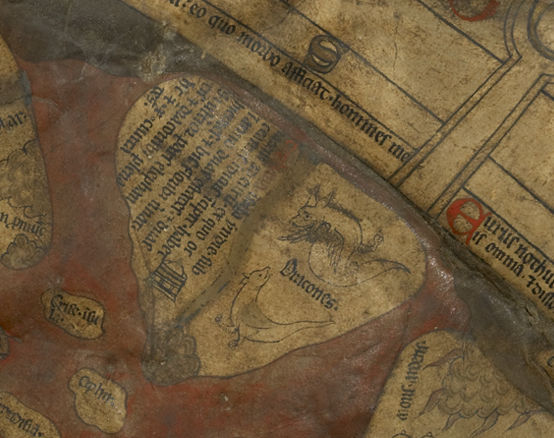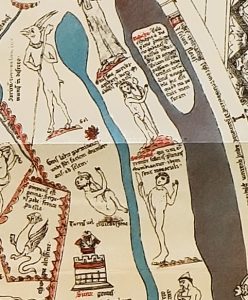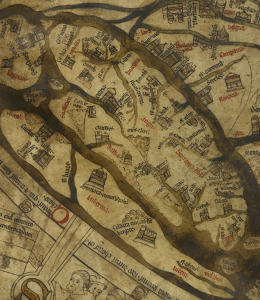I recently re-watched series 3 of Sherlock—having a hard time waiting for the Christmas special, you know—and noted that the last episode contains a pseudo-medieval moment. Mycroft and Sherlock are talking outside the Holmes family home on Christmas Day. Mycroft calls Sherlock a dragon-slayer (rather, he says that’s how Sherlock views himself). Then Mycroft says Sherlock is needed in England and adds, ominously, “Here be dragons.”
That phrase—“here be dragons”—is a way to signal unknown or dangerous territory. Mycroft is saying that Sherlock doesn’t need to go halfway around the world to take out bad guys; there are plenty right there in England. Here be dragons.
This dragon talk is a rather fanciful way to refer to the scientifically-minded Sherlock Holmes. In fact, it harks back to the Middle Ages, which is surely antithetical to everything Sherlock stands for. When I watched this episode, my ears perked up. As many of you know, I recently wrote a book on medieval maps. Mycroft’s fanciful phrase refers to the supposed tendency of these maps to place the words “here be dragons” in the uncharted territories of the world. The phrase has entered popular consciousness because of this popular assumption about medieval maps.
For the most part, this assumption is incorrect. Only one medieval map—dating to the 15th century—contains the inscription, “Here be dragons.” So does a 16th-century globe.* So the phrase “here be dragons” can hardly be called a tradition. And it can hardly be called medieval—by the time the 16th century rolls around, we’re not really in the Middle Ages any longer. Isn’t it interesting how a “tradition” that seems to define the fanciful thinking of the medieval era turns out to be modern instead?
(Wait just a minute while I revel in the fact that I can correct anything having to do with the Holmes brothers . . . Okay, I’m done.)
Historians aren’t sure how the “here be dragons” myth came to be invented. One of the earliest references is from 1928. In Dorothy L. Sayers’ short story, “The Learned Adventure of the Dragon’s Head,” Lord Peter Wimsey says that he saw the phrase “hic dracones” on an old map. Where did Sayers get this idea? We don’t know.
That’s not to say that medieval maps don’t picture dragons. They do. On the Hereford Map (ca. 1300), for example, two dragons appear at the tip of Asia.
 Today, dragons are portrayed as fierce and terrible (think of Smaug from The Hobbit), but in the Middle Ages, they were merely a sub-species of the serpent (when they weren’t being used to talk symbolically about sin, as in the Bible).
Today, dragons are portrayed as fierce and terrible (think of Smaug from The Hobbit), but in the Middle Ages, they were merely a sub-species of the serpent (when they weren’t being used to talk symbolically about sin, as in the Bible).
In fact, there are far more fierce and terrible creatures than dragons on the edge of medieval maps. Just look at the monstrous races clustered along the edge of medieval Africa and Asia.
 And look at England itself. On the Hereford Map, England is located on the northwestern edge of the world, in the same outer zone as the dragons and the monstrous races. Medieval historians were self-conscious about this, referring to the British Isles as “pimples on the sphere of the earth” and “the boundaries of the world.”** England’s edgy position seems to have been dreaded as much as any dragons that might be roaming the periphery of the earth.
And look at England itself. On the Hereford Map, England is located on the northwestern edge of the world, in the same outer zone as the dragons and the monstrous races. Medieval historians were self-conscious about this, referring to the British Isles as “pimples on the sphere of the earth” and “the boundaries of the world.”** England’s edgy position seems to have been dreaded as much as any dragons that might be roaming the periphery of the earth.

Perhaps this is what Mycroft is getting at, even though his dragon facts rest mostly on an invented tradition. What Sherlock has to fear the most are not fantastical creatures, but instead the “ordinary” people of his own world. Isn’t that what we fear, too? We are all—at least sometimes—“on edge.”
Here be dragons? Sort of. But also—here be monsters. Here be ordinary people. Here be you and me.
Notes:
*Chet Van Duzer, “Hic sunt dracones: The Geography and Cartography of Monsters,” in The Ashgate Research Companion to Monsters and the Monstrous, ed. Asa Simon Mittman and Peter Dendle (Ashgate, 2013), 389.
**Asa Simon Mittman, Maps and Monsters in Medieval England (Routledge, 2006), 20, 23.